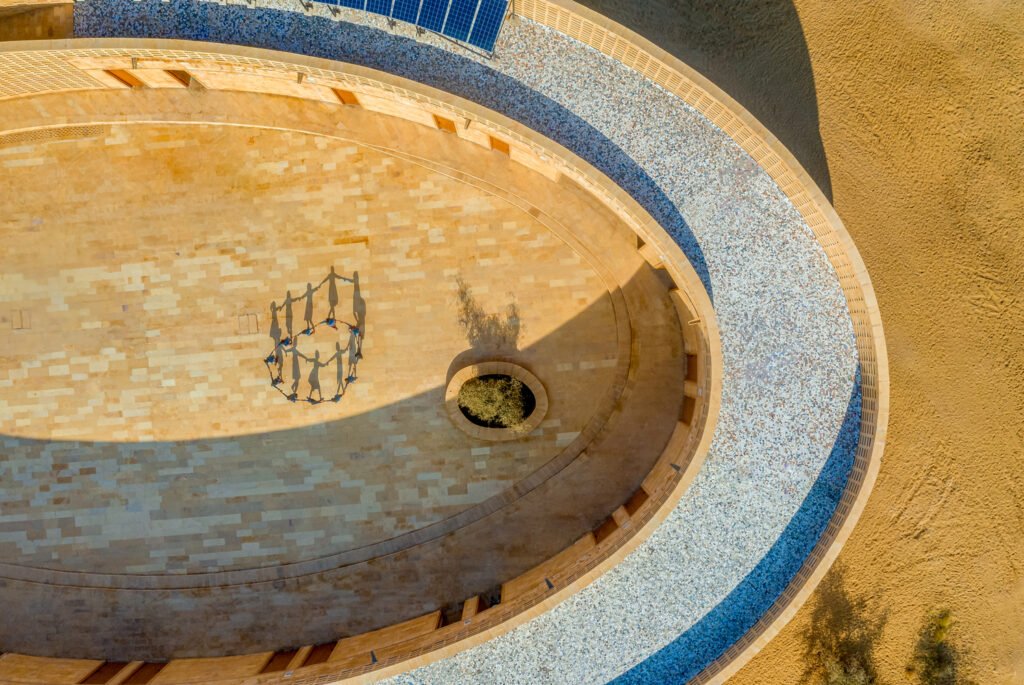Nestled amidst the inhospitable terrain of the Thar Desert, stands a school, which is nothing short of a miraculous symbol of empowerment for a region which was long denied its rightful opportunities. It is a testament to the harmonious blend of Western planning and Indian craftsmanship. The Rajkumari Ratnavati girls school is straight out of a dream, for many and also sets an example proving that no ambition is too grand when fueled by passion, kindness and commitment.
The masterminds behind Rajkumari Ratnavati Girls School

“Architecture has the power to impact the people who experience it,” says Diana Kellogg, founder and principal architect of Diana Kellogg Architects. It is an international award-winning firm based in New York, established in 1992. Known for their high-end residential projects, the firm underwent a transformation, guided by a newfound dedication to sustainable design and community work. When luxury projects became unrewarding, Diana Kellogg embraced a deeper purpose, shifting the focus towards non-profit initiatives as a means of giving back to society.
Diana was approached by the CITTA Foundation of India, captivated by their dedication to supporting underserved families and communities. CITTA is a non-profit organization focused on supporting the lives of economically disadvantaged, geographically remote, and marginalized communities. One of CITTA’s notable projects is the Gyaan Center, which includes the Rajkumari Ratnavati Girls School. Located amidst the hot and arid Thar Desert in Jaisalmer, Rajasthan, this school has garnered global recognition and numerous awards for its distinctive and exceptional features. Michael Dubey, the founder of CITTA, expresses, “The vision is to help the local girls who are really in need of educational opportunities. also the fact that we can bring great educators, designers, and architects from all over the world to engage and enhance it.“
What makes the Rajkumari Ratnavati school special?

There are not one, but many reasons why the school deserves all the attention. This unique school stands as a beacon of hope, addressing the challenges faced by women on a large scale. Catering primarily to girls below the poverty line, in a region plagued by issues such as child marriage, high rates of girl child mortality, and discrimination, the school serves as a powerful agent of empowerment. Its mission is clear: to uplift and empower the girl child in a community where obstacles often seem insurmountable.
It was vital for Kellogg to include local artisans and local craftsmen, mostly the fathers of the girls that would be sent to the school, so you know that the work is in the safest hands. She wanted to remain authentic to the region and show what traditional craft skills could do today. When choosing the material for the school, she was thinking of a lot of options, but then she realized that the stand stone found abundantly in the area in a quarry just 30 km away from the site is the best material. It is a climate-resilient material commonly used in the area.
Recognizing the importance of local involvement and authenticity, Kellogg made a deliberate choice to engage local artisans and craftsmen, many of whom were the fathers of the girls attending the school. This decision ensured that the work was entrusted to skilled hands deeply rooted in the community,completing a full circle of purpose behind the school. Kellogg’s vision also prioritized showcasing the relevance of traditional craft skills, honoring the rich heritage of the region.
Another cultural aspect reflected in the architecture is the traditional veils worn by women. The Jali walls offer a modern interpretation of these veils, serving as a means to promote modesty and respect for the culture. The Jali walls also increase the speed of the wind, leveraging the Venturi effect to naturally cool the building.
Its striking oval shape immediately captivates the observer, symbolizing the resilience and power of feminine energy. The architect’s intention was clear: to create a space that is not only comfortable but also safe for the girls, drawing on the nurturing energy of womanhood. Kellogg describes the school as more than just a structure—”it’s a womb, an egg, a cradle, essentially to hold the girls.”.
How does the school ensure comfortable learning without air conditioning?

When selecting materials for the school, Kellogg considered various options before realizing that the escape from the heat lies within the very stones of Jaisalmer, which also serve as a symbol of the region’s identity.Not only is sandstone a climate-resilient material well-suited to the region’s conditions, but its use also reflects a commitment to sustainability and local resources.
In a region where temperatures soar to a scorching 120°C, the traditional approach proved to be the most effective solution. The architecture facilitates natural air circulation, with elevated windows allowing hot air to escape. Recycled ceramic tiles are used on the rooftop, and the walls of the classrooms are plastered with lime to prevent extreme heat. There is a marginal 6° difference in temperature between the classrooms and the courtyard, a testament to the thoughtful design of the architect.
Emphasis on sustainability

The solar panels installed a top the structure serve multiple purposes, offering sustainable electricity while also providing much-needed shade for the classrooms below and as a play structure for the girls. “Sunlight is very abundant in that part of the world, so I felt it was very important to insist that we use solar power,” says Diana Kellog, who also used them as a canopy for the staircase that leads to the rooftop.
Rainwater harvesting is implemented and collected from both the roof and the courtyard at the school using ancient techniques once practiced in the village. This revival holds profound significance, as it reconnects the school with its cultural heritage and the wisdom of its ancestors. By reintroducing this time-honored technique, Kellogg underscores the importance of sustainability in harmony with the environment.
For Diana Kellogg, a foreign architect in India, the journey was filled with challenges, yet her unwavering determination gave the world a masterpiece. Diana Kellog believes that everyone has the power to enact change. In a message of empowerment, she reminds the community, “Your boys are valuable, so are your girls.” With each stone laid and every detail meticulously crafted, the building emerges as a symbol of progress, empowerment, and possibility in the face of adversity.




